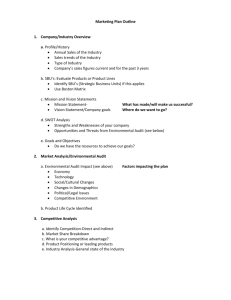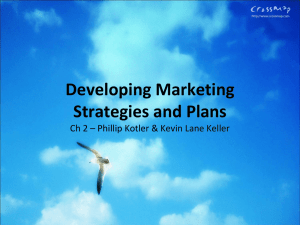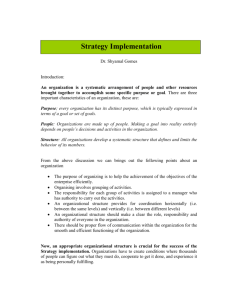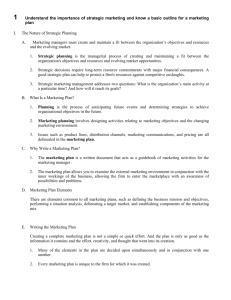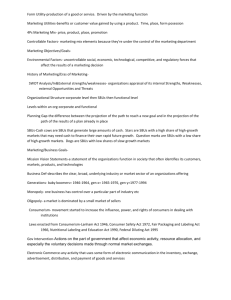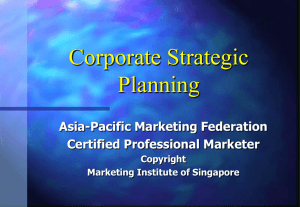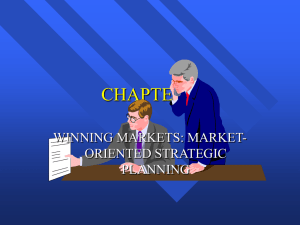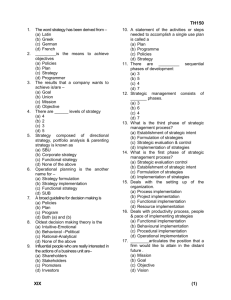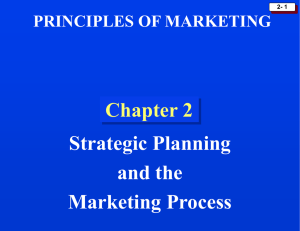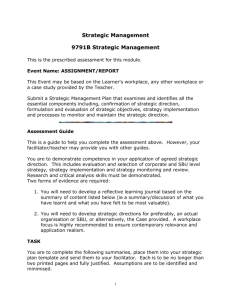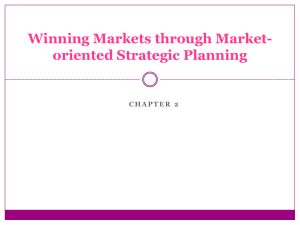Strategic Management Framework
advertisement
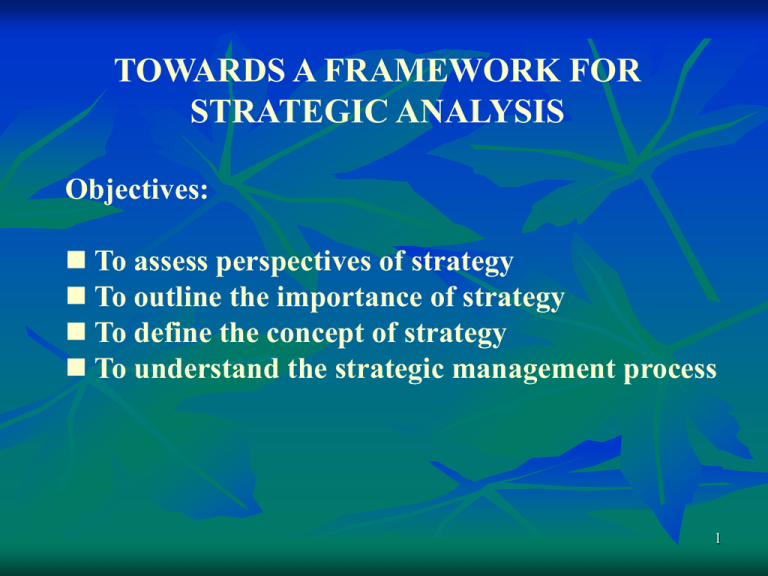
TOWARDS A FRAMEWORK FOR STRATEGIC ANALYSIS Objectives: To assess perspectives of strategy To outline the importance of strategy To define the concept of strategy To understand the strategic management process 1 STRATEGIC MANAGEMENT: RELEVANCE INDUSTRY, BUSINESS AND ECONOMIC CYCLES ARE HIGHLY VOLATILE, UNSTABLE, DYNAMIC AND TURBULENT THERE HAS BEEN A PARADIGM SIFT FROM PROGECTIONISM → LIBERALIZED REGIME 2 STRATEGIC MANAGEMENT: RELEVANCE ▪ LIBERALISATION/ GLOBALIZATION: CRITICAL COMPONENTS Delicensing And Deregulation Liberalization Of Trade Reduction In Direct And Indirect Tariffs PSU Disinvestment And Privatization Inflow of FDI/ FII Investments THE CONSEQUENCES Integration of World Markets Free Movement Of Capital, Labour, Goods And Services Promotion of Trade and Investments and reduced Entry And Trade barriers Vulnerable To Social, Political, and Economic Shocks Aggravate Competition 3 STRATEGIC MANAGEMENT: RELEVANCE ■ STRATEGIES TO BE “CUSTOMER CENTRIC” ■ OPPORTUNITIES TO BE “DISCOVERED AND EXPLOITED” DESPTE IMMENSE AN DFIERCE COMPETITION. ■ “POTENTIALLY DANGEROUS” TO FULFILL ALL ASPECTS OF CUSTOMER NEEDS AND EXPECTATIONS ■ STRATEGIES → “CREATE AND ADD VALUE” 4 STRATEGIC MANAGEMENT: RELEVANCE PRE LIBERALIZATION SCENARIO POST LIBERALIZATION SCENARIO Protected Market High Restrictions High Tariffs/ Regulation Competition Limited Liberalized Market Reduced restrictions Reduced Tariffs Low Entry Barriers Severe Competition 3 Things to Remember: 1. Strategies to Survive 2. Strategies to Grow and Excel 3. Strategies to Sustain 5 STRATEGIC MANAGEMENT: USEFUL APPROACHES Morrison and Lee (1989) Strategy formulation involves knowing: The competitive environment How to allocate resources How to structure organizations How to implement plans Being able to react to events 6 STRATEGIC MANAGEMENT: USEFUL APPROACHES Johnson and Scholes (1999) Strategy is the direction and scope of an organization over the long term which achieves advantage for the organization through its configuration of resources within a changing environment to meet the needs of markets and to fulfill stakeholder expectations. 7 STRATEGIC MANAGEMENT: USEFUL APPROACHES Thinking strategically – the three big strategic questions 1. Where are we now? 2. Where do we want to go? 3. How will we get there? 8 STRATEGIC MANAGEMENT: USEFUL APPROACHES 1. Where are we now? Involves thinking strategically about the company’s external market environment and its internal situation & capabilities 2. Where do we want to go? Involves thinking strategically about what top management wants the company to be like in 5-10 years (levels of performance, financial and strategic outcomes) 3. How will we get there? Involves thinking about what strategy the company should pursue to perform successfully and get from where it is to where it wants to go 9 MINTZBERG VIEW: THE CRITICAL 5 Ps 1. PLAN → A consciously intended course of action, a guideline, or set of guidelines to deal with a situation 2. PATTERN → A stream of actions, a consistency of behaviour 3. PLOY → SPECIFIC MOVES TO OUTWIT AND OUTSMART RIVALS AND COMPETITORS 4. POSITION → In a market or competitive environment (niche), a sort of eco-system where some browse off one segment, and others browse off another 5. PERSPECTIVE → Reflects a firm’s ingrained way of seeing the world, as in corporate culture, dominant ideology, individual’s personality 10 STRATEGIC MANAGEMENT: USEFUL APPROACHES Why corporate strategy is important Corporate strategy involves the entire organization Corporate strategy is likely to concern itself with the survival of the business as a minimum objective and the creation of value added as a maximum objectives Corporate strategy covers the range and depth of the organization's activities Corporate strategy directs the changing and evolving relationship of the organization with its environment Corporate strategy is central to the development of sustainable competitive advantage Corporate strategy is crucial to adding value 11 STRATEGIC MANAGEMENT: USEFUL APPROACHES Levels of strategy (1) Corporate Level strategic decisions are concerned with: Overall purpose and scope Adding value to shareholder investment portfolio issues Resource allocation between SBUs Structure and control of SBUs Corporate financial strategy 12 STRATEGIC MANAGEMENT: USEFUL APPROACHES Levels of strategy (2) Business Unit strategy is concerned with: Competitive strategy Developing market opportunities Developing new products/ services Resource allocation within the SBU Structure and control of the SBU 13 STRATEGIC MANAGEMENT: USEFUL APPROACHES Levels of strategy (3) Operational Strategies are concerned with: The integration of resources, processes, people and skills Implementation of strategy 14 The Various Levels of Strategic Management Process Corporate Level Strategy Top Management Decision by Corporate Board Members/ conglomerates/ groups • Mergers/ Acquisitions SBU Level Strategy • Expansion & Diversification • Product Portfolio Mize • Divestiture • Alliances & Partnerships • Collaborative Strategies 15 The Various Levels of Strategic Management Process Decision of Business Heads/ Unit Managers Comprising the following SBU Level Strategy • Increase in MKT Share (%) • Change in Product Portfolio • Improve Financial Performance • Positioning Strategy All Business functions to BE Interrelated Functional Level Strategy • HR Strategy • Marketing Strategy • IT & communication • Financial Strategy Operational Level Strategy Supervision and Control of • Business functions • Business Processes 16 STRATEGIC MANAGEMENT: PROCESS ETOP LINK WITH OBJECTIVES. GOALS/ PURPOSE INTERNAL RESOURCES/ CAPABILITY STRATEGY ACTION PLANS ORGANIZATIONS TO POSSSESS DUAL CAPABILITY 17 STRATEGIC MANAGEMENT: PROCESS ORGANIZATIONS TO POSSSESS DUAL CAPABILITY 1. Build and sustain competitive advantage 2. Earn above average profits MISSION VISION OBJECTIVES CSO (Common Shared Objectives) STRATEGIC INTENT FORMULATION OF ACTION PLANS IMPLEMENTATION OF ACTION PLANS AUDIT REVIEW 18 THE STRATEGIC MANAGEMENT PROCESS A → ANALYSIS D → DESIGN I → IMPLEMENTATION A → AUDIT Suitable Framework for formulation implementation and control on strategy A → ANALYSIS Analyze and Define External Conditions The PEST ENVIRONMENTAL SCAN COMPETITOR ANALYSIS Identifying Competitive Conditions Assessing Degree and Structure of Conditions and Competition PORTERS FIVE FORCES MODEL → INDUSTRY COMPETITIVENESS VALUE CHAIN ANALYSIS 19 THE STRATEGIC MANAGEMENT PROCESS INTERNAL SCANNING Allocation of Resources Capability and Competency Mapping Strategic Group Mapping/ GIA Performance Bench Marking SWOT Analysis CSFs Core Vs Distinctive Competency 20 THE STRATEGIC MANAGEMENT PROCESS D DESIGN/ FORMATION OF STRATEGY Design Strategic Action Plans based on external environmental conditions and internal resource mapping PORTER’S → Generic Strategies Integrated Strategic Approach Hyper competition in Fast Cycle Sectors Early Mover Advantage Sustain Ability Traditional Grand Strategies Expansion Market Diversity Diversification Product Diversity 21 THE STRATEGIC MANAGEMENT PROCESS BCG Growth Share Matrix and ILC Model Strategic Options Under Various Industry Settings International Level Strategy Turn Around Strategy Consolidation and Restructuring Options Mergers/ Acquisition Synergies and Value Addition 22 THE STRATEGIC MANAGEMENT PROCESS I → IMPLEMENTATION/ EXECUTION Corporate Governance and Ethics Strategic Leadership Change Management Organization Structure and controls HRM Initiatives Revamp of Process, Systems, Resources and Facilitating Strategic Change (Critical 7 S’s MODEL) 23 THE STRATEGIC MANAGEMENT PROCESS A → AUDIT Performance Measurement and Audit Periodic Monitoring and Evaluation Classify Yardsticks and Measure for Corporate Success Identify Critical Gaps/ Issues Introduce Course Corrective Actions Continuous Cyclical Process The Balanced Scorecard Model NGOs/ VOs → Corporate Social Responsibility Evaluation → Schemes/ Programs 24
